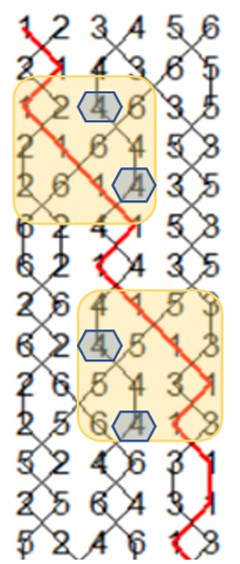Only partly. It certainly isn’t the whole story. I am starting to find it hard to describe what I am doing and now understand why others have said the same. What I am doing is blending existing knowledge with new knowledge and skills. The elements I can identify thus far include:
- Awareness of the places both of my bells are in, though I couldn’t state them aloud or even silently
- Knowing that the place notation (pn) reverses at the half-lead, so in Cambridge there is a ‘4’ before AND after it.
- Observing the pn happening in practice & why certain places are made Eg:
- Treble dodge in 3-4 means pn=2
- pn of 3 forces a dodge on the front and makes a bell stay at the back ready to dodge with a different partner
- Using the half lead (HL) pn as well as the lead end (LE) pn as an anchor point
- Using the treble’s 3-4 dodge as an additional pn anchor point. This needs a touch of explanation. In Cambridge, the pn is identical before and after this point, being:

In words this might be summarised as LE [3,4] 2 [3,4] HL
I explain this as “3, 4 gets the treble up to the middle where there is pn=2, then 3, 4 gets it to the back”. What I am sort of visualising is a box of plain hunt on 4 with the treble in the middle of it. (See diagram).
I have highlighted the place-making bell only at backstrokes as that is where the place is made. I note that the SAME bell makes each of these places within a half lead, but I haven’t yet found this useful whilst ringing.
- Awareness of elements of the place bells I am ringing (Eg I know that my right hand bell ran out, so it is 3rds PB and will make 5ths at the half lead, or I know my left hand bell made 2nds while the treble was in 3-4 down, so it’s 5th’s place bell & will make 2nds at the lead end (2nds pb) & make 2nds when the treble dodges 3-4 up.
- Awareness of “blue line” features of a method, such as that Cambridge places occupy a whole half lead and that the front work is similarly long meaning one bell could be in 1-2 while the other is in 3-4 for an extended period.
- Learning certain “signpost” points, such as what various pair combinations do at a HL, eg scissor dodge, dodge together in 1-2 or 3-4.
Other observations will no doubt creep in. I hope to be able to add an understanding of coursing order into the ringing. I can do this in Plain Bob, but to be fair, I still find it hard to see & make use of coursing order in Cambridge in the tower, let alone in hand, other than that a coursing pair dodge together at the back. It is easier in Yorkshire, where I can see coursing pairs working sets of places.